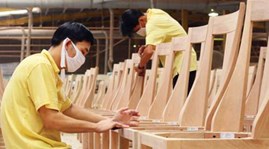Wood exports forecast to soar in 2015
 |
The positive results for the January-February period now have economists forecasting that exports for the industry could climb to an all time high of US$7 billion for 2015.
Vietnam Timber and Forest Products Association (Vifores) General Secretary Nguyen Ton Quyen, recently sat down with reporters to give an extensive interview to discuss the prospects for exports in the coming year.
Following are key excerpts from the interview.
Reporter: Do you think the impressive figure of wood exports for2014 can add fresh impetus to the industry’s exports this year?
Mr Quyen: Last year, the export value of wood and wooden products jumped 11.5% on-year to US$6.23 billion. Exports to the key markets of the US and Japan increased significantly by 14.17% and 19.47% respectively.
Exports to newly-emerging markets like the Middle East, Australia and ASEAN also saw positive growth. Over the past seven years, the export value of the wood industry has steadily grew 15% per year on average.
This yearwe expect the industry to hitUS$7 billion in exports forthe year.
Reporter: Despite bright prospects for wood exports this year, could you elaborateon challenges faced by the sector?
Mr Quyen: In my opinion, the sector will face a number of challenges as more free trade agreements (FTAs) such as Vietnam-EU FTA and the Trans-Pacific Partnership, to name only a few, come into effect.
These FTAs place strict requirements on all wood exports to comply with the demanding rules for origin certificates. The situation is complicated by the fact that Vietnam purchases wood from several nations around the globe and not all countries provide the origin certificate.
Therefore, Vietnamese businesses have to factor this in to their decision to purchase wood for other countries as it could significantly affect their costs and ultimately their profits.
Another problem area is that under the FTAs, wooden products from developed nations will also find their way to the Vietnam market leading to tougher competition for retail sales. In fact, many domestic products currently find it difficult to compete with the imported ones.
Moreover, although the bank lending interest rates have decreased, production costs for domestic products remain high, especially transport costs by sea.
These are the biggest challenges domestic businesses will face in the upcoming year.
Reporter: What are the solutions for making the best of opportunities from the FTAs?
Mr Quyen: China is a major market for wooden planks and artificial board and one of the fastest growing. Recently, there has been a decline in the demand for these products by Chinese businesses however.
So the FTAs provide the opportunity to replace other overseas markets to make up for the decline in sales to China. In fact, wooden planks are now sold at between US$700 and US$1,200 per cubic metre, so that is a real opportunity.
We also have a plan to restructure wood products by using wood in the country to produce high-valueadded products. Especially, the industry is exerting greater efforts to make breakthroughs in technologies to create high quality with increased added value.
Reporter: Do you think that new export markets remain a thorny problem for export businesses?
Mr Quyen: Russia is a new market. In 2013, the Ministry of Industry and Trade (MoIT) and the Government encouraged the wood, seafood, and garment and textile sectors to accelerate exports to the Russian market.
However, there remain problems in the regulations to export wooden products to Russia. For example, wooden planks in Russia currently originate mainly from the Middle East and Siberia which have encountered difficulties in terms of transport, climate and labour.
It would be beneficial if the State could negotiate a formal agreement with Russia to reduce difficulties in terms of raw materials, labour, customs and tax formalities. Ourrecently signed FTA with the Customs Union of Russia, Belarus and Kazakhstan doesn’t address these current issues as parts of it won’t be effective for two years. Another problem area is complying with origin certificates for exports to the EU, businesses. The rules are extremely complicated but in essence they require raw materials to be acquired within Vietnam.
If a domestic business purchases raw materials from outside of the country then it becomes much more complicated and costly to comply with the rules and regulations. Last year the industry imported 80% of its raw materials and so the problem is huge. The best solution is to reduce the industry’s dependence on imports and we currently are hoping to reduce imports by at least 25% by 2020.
Reporter: Thank you very much./.
(VOV)

